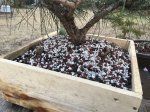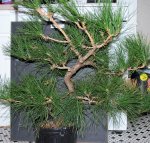Hey everyone! I have a JBP I acquired late last summer, its my first and only jbp so I am still learning. Its fairly tall, about 30" and the trunk is about 3" at the base but then is a static 1.5-2" all the way up. So it very much lacks taper. From what I know, there are only 2 options to improve the taper, beyond putting it in the ground, then trunk chopping. Being that I live in a rental I don't want to put anything in the ground long-term. So my two options I think are to make it a bit shorter and develop some sacrifice branches. I don't want to chop too much as I do want to keep it as at least a medium sized tree. So i'll take a little off the top, but I don't know how to grow sacrifice branches on a pine. What I mean by that is: if I am growing sacrifice branches do I perform any of the "standard" jbp maintenance techniques? Decandle, bud selection, needle pluck... or just let it grow untouched?
I put a couple pics, but not sure they are necessary as I'm wanting to understand what should/shouldn't be done for a jbp sacrifice branch. On a deciduous, its straight forward: just let it go untouched. But not sure to what extent that applies to jbp.
Thank you
I put a couple pics, but not sure they are necessary as I'm wanting to understand what should/shouldn't be done for a jbp sacrifice branch. On a deciduous, its straight forward: just let it go untouched. But not sure to what extent that applies to jbp.
Thank you


